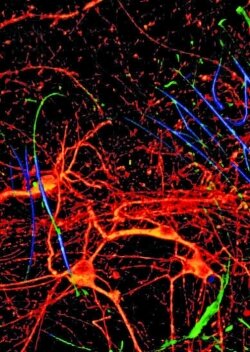Issue Date: September 3, 2012 Web Date: August 30, 2012
Wiring Up Living Tissue
News Channels: Materials SCENE, Biological SCENE, Nano SCENE
Keywords: cyborg, nanoelectronic, engineered tissue

Science and science fiction moved a little closer together with a report that researchers have created so-called cyborg tissue that seamlessly integrates electronics with living cells (Nat. Mater., DOI: 10.1038/nmat3404). The new synthetic biomaterial could be used to probe how cells respond to drugs and might one day lead to smart prosthetics and tissue implants that sense and respond to their biological environment.
In recent years, researchers have devised several examples of flexible and stretchable electronics interfaced with tissue at its surface, explains Harvard University chemistry professor Charles M. Lieber, who spearheaded creation of the cyborg tissue along with Harvard Medical School’s Daniel S. Kohane. The new cyborg tissue takes the bioelectronics interface even further, Lieber says, by integrating the electronics within the tissue in a three-dimensional manner.
“This is the ultimate extension of the science-fiction concept of a cyborg because we’re essentially merging electronic circuitry with biological circuitry,” Lieber says. “The electronics now look like the natural extracellular matrix.”
To intimately connect the electronic and biological components, Lieber and Kohane’s team struck upon the idea of creating a 3-D scaffold of biocompatible, nanoscale electronics that would provide mechanical support—just as the extracellular matrix does—for tissue to grow upon. They created a mesh of silicon wires, approximately 80 nm in diameter, upon which they constructed field-effect transistors at various points via lithography. The researchers then rolled the mesh or let it spring by design into a 3-D shape. Finally, they seeded the mesh with various types of cells, which they then coaxed to grow into tissue.
In one example, the team seeded the electronic scaffold with cardiac cells. They were able to detect the electrical signals the cells generated from within the engineered tissue in response to noradrenaline, a drug that stimulates cardiac contraction.
“There’s a whole toolbox of nanoelectronic devices that one can think about building into these 3-D circuits and merging them with biological information processing systems,” Lieber says, citing photonic devices as one example.
“This is really exciting work,” comments Yi Cui, a nanomaterials expert at Stanford University. “The concept of incorporating electronic sensors into a 3-D scaffold for local sensing in tissue opens up exciting opportunities. It can provide localized real-time monitoring of cellular activities and physicochemical change,” he says.
“This research opens a new direction in interfacing nanoelectronics networks with biological systems at an unprecedented level,” adds Zhong Lin Wang, a professor of nanoscience at Georgia Tech.
- Chemical & Engineering News
- ISSN 0009-2347
- Copyright © American Chemical Society